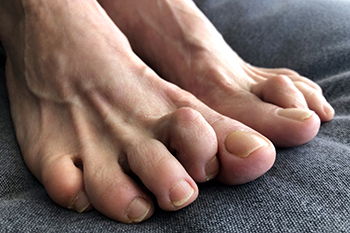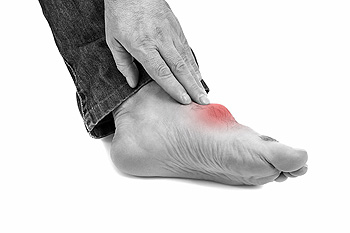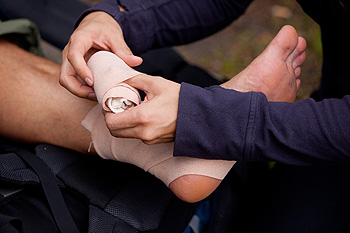Items filtered by date: July 2021
What Can Cause Hammertoe?
 The foot condition that is known as hammertoe is considered to be a deformity of the joints and ligaments. It affects the middle joints of the second and third toe, and causes them to bend downward, resembling a hammer. This ailment can develop from genetic reasons, or if a foot injury has occurred. Additionally, if the patient has high arches, or frequently wears shoes that do not have adequate room for the toes to move freely in, the beginning stages of hammertoe may develop. A common medical condition that may contribute to the onset of hammertoe can be arthritis, which can cause severe pain and discomfort. Mild relief may be found when shoes that are worn fit properly, and it may be beneficial to wear proper insoles. If you have hammertoe, it is strongly suggested that you are under the care of a podiatrist who can guide you toward feeling better.
The foot condition that is known as hammertoe is considered to be a deformity of the joints and ligaments. It affects the middle joints of the second and third toe, and causes them to bend downward, resembling a hammer. This ailment can develop from genetic reasons, or if a foot injury has occurred. Additionally, if the patient has high arches, or frequently wears shoes that do not have adequate room for the toes to move freely in, the beginning stages of hammertoe may develop. A common medical condition that may contribute to the onset of hammertoe can be arthritis, which can cause severe pain and discomfort. Mild relief may be found when shoes that are worn fit properly, and it may be beneficial to wear proper insoles. If you have hammertoe, it is strongly suggested that you are under the care of a podiatrist who can guide you toward feeling better.
Hammertoes can be a painful condition to live with. For more information, contact Dr. John P. Beaupied of Palos Podiatry. Our doctor will answer any of your foot- and ankle-related questions.
Hammertoe
Hammertoe is a foot deformity that occurs due to an imbalance in the muscles, tendons, or ligaments that normally hold the toe straight. It can be caused by the type of shoes you wear, your foot structure, trauma, and certain disease processes.
Symptoms
- Painful and/or difficult toe movement
- Swelling
- Joint stiffness
- Calluses/Corns
- Physical deformity
Risk Factors
- Age – The risk of hammertoe increases with age
- Sex – Women are more likely to have hammertoe compared to men
- Toe Length – You are more likely to develop hammertoe if your second toe is longer than your big toe
- Certain Diseases – Arthritis and diabetes may make you more likely to develop hammertoe
Treatment
If you have hammertoe, you should change into a more comfortable shoe that provides enough room for your toes. Exercises such as picking up marbles may strengthen and stretch your toe muscles. Nevertheless, it is important to seek assistance from a podiatrist in order to determine the severity of your hammertoe and see which treatment option will work best for you.
If you have any questions, please feel free to contact our office located in Palos Heights, IL . We offer the newest diagnostic and treatment technologies for all your foot care needs.
What to Do About Your Toenail Infection
 Toenail infections are very common and are caused by bacteria and fungi growing on or underneath the toenail. These fungi often thrive and grow in warm and moist environments like public pools, locker rooms and showers. Signs of a fungal nail infection include the nail thickening, turning yellow or brown, becoming crumbly, pain or the nail separating from the nail bed. Patients who notice these symptoms should consult with a podiatrist for treatment options, especially diabetic patients since the infection can lead to further complications. Upon visiting a podiatrist, they will check the nail and suggest a treatment option. Common treatment options include antifungal medications, removing the nail, or antifungal nail paints.
Toenail infections are very common and are caused by bacteria and fungi growing on or underneath the toenail. These fungi often thrive and grow in warm and moist environments like public pools, locker rooms and showers. Signs of a fungal nail infection include the nail thickening, turning yellow or brown, becoming crumbly, pain or the nail separating from the nail bed. Patients who notice these symptoms should consult with a podiatrist for treatment options, especially diabetic patients since the infection can lead to further complications. Upon visiting a podiatrist, they will check the nail and suggest a treatment option. Common treatment options include antifungal medications, removing the nail, or antifungal nail paints.
If left untreated, toenail fungus may spread to other toenails, skin, or even fingernails. If you suspect you have toenail fungus it is important to seek treatment right away. For more information about treatment, contact Dr. John P. Beaupied of Palos Podiatry. Our doctor can provide the care you need to keep you pain-free and on your feet.
Symptoms
- Warped or oddly shaped nails
- Yellowish nails
- Loose/separated nail
- Buildup of bits and pieces of nail fragments under the nail
- Brittle, broken, thickened nail
Treatment
If self-care strategies and over-the-counter medications does not help your fungus, your podiatrist may give you a prescription drug instead. Even if you find relief from your toenail fungus symptoms, you may experience a repeat infection in the future.
Prevention
In order to prevent getting toenail fungus in the future, you should always make sure to wash your feet with soap and water. After washing, it is important to dry your feet thoroughly especially in between the toes. When trimming your toenails, be sure to trim straight across instead of in a rounded shape. It is crucial not to cover up discolored nails with nail polish because that will prevent your nail from being able to “breathe”.
In some cases, surgical procedure may be needed to remove the toenail fungus. Consult with your podiatrist about the best treatment options for your case of toenail fungus.
If you have any questions, please feel free to contact our office located in Palos Heights, IL . We offer the newest diagnostic and treatment technologies for all your foot care needs.
Risk Factors That Make Gout More Likely
 Gout is considered to be a type of arthritis caused by a buildup of uric acid in the bloodstream. When there is an overabundance of uric acid, it can crystallize and become lodged in the joints. This can produce severe pain, swelling, redness, and joint stiffness. Often, the joints of the big toe are most commonly affected. Certain conditions make gout more likely to occur. These include consuming foods that contain high fructose corn syrup or are high in purines, being obese, having chronic kidney disease, taking certain drugs, and having cancers or blood disorders. Gout can also be hereditary. If you experience a gout flareup, seeing a podiatrist for treatment and diet plans can help.
Gout is considered to be a type of arthritis caused by a buildup of uric acid in the bloodstream. When there is an overabundance of uric acid, it can crystallize and become lodged in the joints. This can produce severe pain, swelling, redness, and joint stiffness. Often, the joints of the big toe are most commonly affected. Certain conditions make gout more likely to occur. These include consuming foods that contain high fructose corn syrup or are high in purines, being obese, having chronic kidney disease, taking certain drugs, and having cancers or blood disorders. Gout can also be hereditary. If you experience a gout flareup, seeing a podiatrist for treatment and diet plans can help.
Gout is a foot condition that requires certain treatment and care. If you are seeking treatment, contact Dr. John P. Beaupied from Palos Podiatry. Our doctor will treat your foot and ankle needs.
What Is Gout?
Gout is a type of arthritis caused by a buildup of uric acid in the bloodstream. It often develops in the foot, especially the big toe area, although it can manifest in other parts of the body as well. Gout can make walking and standing very painful and is especially common in diabetics and the obese.
People typically get gout because of a poor diet. Genetic predisposition is also a factor. The children of parents who have had gout frequently have a chance of developing it themselves.
Gout can easily be identified by redness and inflammation of the big toe and the surrounding areas of the foot. Other symptoms include extreme fatigue, joint pain, and running high fevers. Sometimes corticosteroid drugs can be prescribed to treat gout, but the best way to combat this disease is to get more exercise and eat a better diet.
If you have any questions please feel free to contact our office located in Palos Heights, IL . We offer the newest diagnostic and treatment technologies for all your foot and ankle needs.
Arthritis Can Cause Pain in the Feet and Ankles
How Podiatrists Can Help with Ankle Sprains
 One of the most common injuries that occurs while playing sports is an ankle sprain. An ankle sprain occurs when a sudden twist or force over stretches or tears the ligaments that connect to the bones in the joints. Common indications of an ankle sprain include swelling around the ankle, bruising, pain, and difficulty bending the ankle. Patients who are unable to walk on their ankle, have significant swelling, or have symptoms that last for multiple days should consult with a podiatrist for treatment. Because it can be hard to differentiate between an ankle sprain and an ankle fracture, patients who are experiencing significant pain in the ankle should consult with a podiatrist. A podiatrist will be able to evaluate the injury through tools like imaging to accurately diagnose and treat the injury.
One of the most common injuries that occurs while playing sports is an ankle sprain. An ankle sprain occurs when a sudden twist or force over stretches or tears the ligaments that connect to the bones in the joints. Common indications of an ankle sprain include swelling around the ankle, bruising, pain, and difficulty bending the ankle. Patients who are unable to walk on their ankle, have significant swelling, or have symptoms that last for multiple days should consult with a podiatrist for treatment. Because it can be hard to differentiate between an ankle sprain and an ankle fracture, patients who are experiencing significant pain in the ankle should consult with a podiatrist. A podiatrist will be able to evaluate the injury through tools like imaging to accurately diagnose and treat the injury.
Although ankle sprains are common, they aren’t always minor injuries. If you need your ankle injury looked at, contact Dr. John P. Beaupied from Palos Podiatry. Our doctor can provide the care you need to keep you pain-free and on your feet.
How Does an Ankle Sprain Occur?
Ankle sprains are the result of a tear in the ligaments within the ankle. These injuries may happen when you make a rapid shifting movement while your foot is planted. A less common way to sprain your ankle is when your ankle rolls inward while your foot turns outward.
What Are the Symptoms?
- Pain at the sight of the tear
- Bruising/Swelling
- Ankle area is tender to touch
- In severe cases, may hear/feel something tear
- Skin discoloration
Preventing a Sprain
- Wearing appropriate shoes for the occasion
- Stretching before exercises and sports
- Knowing your limits
Treatment of a Sprain
In many cases, the RICE method (Rest, Ice, Compression, and Elevate) is used to treat ankle sprains. However, you should see a podiatrist to see which treatment option would work best with your injury. In severe cases, surgery may be required.
It is important to ask your doctor about rehab options after you receive treatment for your injury. Stretching, strength training, and balance exercises may help the ankle heal while also preventing further injury.
If you have any questions, please feel free to contact our office located in Palos Heights, IL . We offer the newest diagnostic and treatment technologies for all your foot care needs.




